Wooden baffles at Long Branch Rifle Range in Mississauga
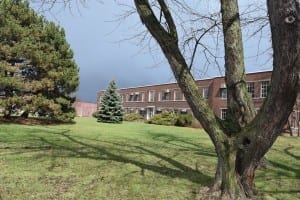
May 3, 2105 Jane’s Walk in Lakeview begins at 12:00 noon at front yard of Small Arms Building at Dixie Road and Lakeshore Road East. Jaan Pill photo
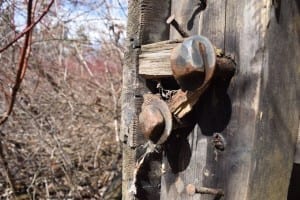
Detail from baffle located on trail leading from Lakeshore Road East to Lake Ontario shoreline. The image tells me that some reflected light in the shadows might be helpful, or perhaps the best strategy would be to seek to take the shot on a slightly overcast day. The photos on this page are by Jaan Pill
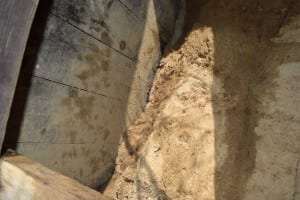
Over a period of many decades, the earth within the baffles has begun to make its way to lower ground.
Join us for a Sunday, May 3, 2015 Jane’s Walk during which City of Mississauga Ward 1 Councillor Jim Tovey will provide the back story related to the wooden baffles located north of the Lake Ontario shoreline, east of Applewood Creek.
Over many decades, the forces of gravity have served to cause the earth within some of the baffles to spill out.
The story behind the baffles is a part of Canadian military history. Join us for a great walk starting at 12:00 noon on Sunday, May 3, 2015 at the front yard at the Small Arms Building, at Dixie Road and Lakeshore Road East in Mississauga.
Click here to access a Google Map Aerial View of the baffles >
Context for the baffles: Kl: A History of the Nazi Concentration Camps (2015)
Many contexts come to mind, for me, when I observe the baffles. Of the many contexts – involving two World Wars – that are available, one frame of reference is outlined in a recent study entitled: Kl: A History of the Nazi Concentration Camps (2015).
A blurb for the book at the Toronto Public Library website notes:
“In a landmark work of history, Nikolaus Wachsmann offers an unprecedented, integrated account of the Nazi concentration camps from their inception in 1933 through their demise, seventy years ago, in the spring of 1945. The Third Reich has been studied in more depth than virtually any other period in history, and yet until now there has been no history of the camp system that tells the full story of its broad development and the everyday experiences of its inhabitants, both perpetrators and victims, and all those living in what Primo Levi called ‘the gray zone.’
“In KL, Wachsmann fills this glaring gap in our understanding. He not only synthesizes a new generation of scholarly work, much of it untranslated and unknown outside of Germany, but also presents startling revelations, based on many years of archival research, about the functioning and scope of the camp system. Examining, close up, life and death inside the camps, and adopting a wider lens to show how the camp system was shaped by changing political, legal, social, economic, and military forces, Wachsmann produces a unified picture of the Nazi regime and its camps that we have never seen before.
“A boldly ambitious work of deep importance, KL is destined to be a classic in the history of the twentieth century.”
[End of text]
I have chosen two passages from the book, the first of which is from the Preface (p. 13). The numbers in square brackets are superscript numbers for the endnotes. I’ve placed them in square brackets as I have not yet figured out how to set superscript numbers in WordPress:
Specialist study of the KL (from the German Konzentrationlager)
“In sharp contrast to survivors, the wider academic community was slow to engage with the KL. A few specialist studies appeared in the late 1940s and 1950s, particularly on medical aspects. [43] But it was not until the 1960s and 1970s that academic historians published preliminary surveys of some indi vidual Nazi camps and the wider KL complex, based on documentary research. Most influential were the works of two young German academics, Martin Broszat’s pioneering survey of the camp system’s development and Falk Pingel’s powerful study of life inside. [44] Such historical analyses were aug mented by works from scholars in other disciplines , on themes like the perpetrator mind and the experience of survival. [45]
“Despite inevitable shortcomings, these early studies made important contributions to knowledge about the SS concentration camps. But they remained exceptions and could only sketch outlines. To write a comprehensive history of the camps, Broszat himself concluded in 1970, was simply impossible, be cause of the dearth of detailed research. [46] Paradoxically, this void was created, at least in part, by the misguided belief that there was little more to learn about the camps, an assumption shared by even some otherwise sharp-eyed observers. [47] In reality, scholars were only starting to discover the KL.
“Historical knowledge advanced rapidly in the 1980s and 1990s, above all in Germany itself. With grassroots history on the rise, local activists scrutinized the record of former camps in their neighborhood. Meanwhile, camp memorials moved beyond remembrance and developed into places of scholarship. The opening of the archives in Eastern Europe, following the end of the Cold War, provided further momentum for research. Meanwhile, a younger generation of academics untainted by the past was discovering the Third Reich as a subject and established the study of its camps as a distinct historiographical field, producing major works like Karin Orth’s account of the KL organization and structure. [48] Having been ignored for so long, the study of the SS concentration camps was now booming, at least in Germany (few studies were translated). [49]”
[End of excerpt]
Flight from the Red Army
The following passage is from Chapter 11, “Death or Freedom” (pp. 554-555), in a section entitled “Flight from the Red Army”:
“On January 12, 1945, the Soviet forces launched a devastating offensive that forced the Third Reich to its knees. Tanks broke through along the vast Eastern Front, sweeping past Wehrmacht defenses, and advanced rapidly toward the German heartland. When the Red Army regrouped at the end of the month, the front line had been completely redrawn. The Third Reich had lost its last foothold in occupied Poland, as well as other vital territory-East Prussia, East Brandenburg, and Silesia – as millions of German civilians joined the retreating Wehrmacht in a desperate mass flight. [58]
“In the path of Soviet troops had stood three big camp complexes Auschwitz, Gross-Rosen, and Stutthof – which held over one hundred and ninety thousand prisoners in mid-January 1945, more than a quarter of all KL inmates. [59] Earlier SS discussions about the full evacuation of these camps had involved the respective Gauleiter and higher SS and police leaders, who held significant sway over the evacuations. [60] The WVHA had played a key role, as well. It was Oswald Pohl who had first ordered the Auschwitz SS to plan for retreat, and when he visited the camp one last time, around November 1944, he examined the blueprint drafted by his protege, Commandant Richard Baer, with the regional party, police, and SS authorities.[61] Back in Oranienburg, Pohl’s managers would decide on the final destination of pris oner transports from the abandoned camps. [62] Still, they could not micromanage events from afar, given the rapid developments on the ground, and left most of the logistical details to local SS commandants and their officers. [63]”
[End of excerpt]
Additional context: Long Branch Outdoor Rifle Range: Cultural Heritage Assessment (September 2013)
Click here to access the above-named document >
Executive Summary
The above-noted document was prepared by Culture Division, Community Services, City of Mississauga. An Executive Summary (I’ve made one spelling correction) of the assessment reads:
“The Outdoor Firing Range, located west of the Small Arms Building at 1300 Lakeshore Road East, merits designation under the Ontario Heritage Act for its historical, architectural and contextual value.
“The military usage of this property extends as far back as 1891 when the Ontario Rifle Association relocated here from the west end of Toronto’s waterfront. In 1910, Canada’s Department of Militia and Defense (renamed the Department of National Defense in 1922) acquired the property from the City of Toronto and constructed the wooden baffles which remain today on the property. This site also once contained the administrative offices for the Royal Flying Corp of Canada in 1917. These offices were demolished by the 1930s.
“The Department of National Defense constructed firing booths to [complement] the outdoor range in 1940 as part of the #3 Militia Training Camp at the Long Branch Rifle Ranges.
“The #3 Militia Training Camp was established to train and prepare militiamen for World War II. The Outdoor Firing Range was used primarily for shooting practice to test the rifles being produced at the Small Arms Factory. The remnant wooden baffles and concrete backstop are all that remain today of the entire Outdoor Firing Range facility. The fact that these wooden baffles and concrete backstop were incorporated into the 1940 expansion of the Range, and not demolished, makes these remnants a significant cultural heritage feature in Ontario of twentieth century Canadian military history.”
Updates
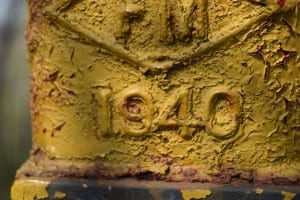
Image from Arsenal Lands west of Small Arms Building at Dixie Road and Lakeshore Road East. Jaan Pill photo
The reference to the Red Army brings to mind a May 4, 2015 CBC article entitled: “VE-Day tarnished by new war of words between Russia, the West: Once joint celebration has become new high-water mark in Cold War II.”
A May 7, 2015 New York Times article is entitled: ” ‘Forbidden Films’ Exhumes Nazi Poison From the Movie Vaults.”
The opening paragraphs read:
“The Third Reich was not only a totalitarian state but also a total multimedia regime. Seven decades after its fiery collapse, the embers remain — including some 1,200 feature films produced under Joseph Goebbels’s ministry of propaganda. Are they historical evidence, incitements to murder, fascist pornography, evergreen entertainments, toxic waste or passé kitsch? All of the above?
“Those questions are raised by ‘Forbidden Films: The Hidden Legacy of Nazi Film,’ a documentary essay by the German filmmaker Felix Moeller, opening May 13 at Film Forum for a weeklong, free-admission run.
“Mr. Moeller, born 20 years after Germany’s defeat, is concerned about what he sees as youthful disinterest in the Nazi period and the concurrent rise of right-wing nationalism in Europe. He arrived at “Forbidden Films,” he said by telephone from Berlin, after making ‘Harlan: In the Shadow of Jew Süss,’ a documentary about the family legacy of Nazi Germany’s most celebrated director, Veit Harlan. Harlan’s most notorious film, “Jew Süss” (1940) — a period melodrama in which a Jewish moneylender connives to take control of the duchy of Württemberg — is as incontrovertibly anti-Semitic as it was enormously popular.”
[End of excerpt]
Updates
A Feb. 7, 2016 Guardian article is entitled: “‘My family resisted the Nazis’: why director had to film Alone in Berlin.”
An Aug. 15, 2016 Guardian article is entitled: “Joseph Goebbels’ 105-year-old secretary: ‘No one believes me now, but I knew nothing’: Brunhilde Pomsel worked at the heart of the Nazis’ propaganda machine. As a film about her life is released, she discusses her lack of remorse and the private side of her monstrous boss.”

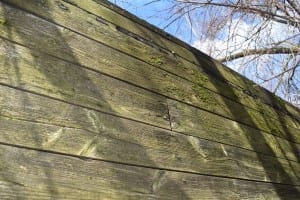
Leave a Reply
Want to join the discussion?Feel free to contribute!